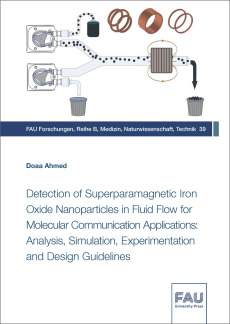Doaa Ahmed
Detection of Superparamagnetic Iron Oxide Nanoparticles in Fluid Flow for Molecular Communication Applications: Analysis, Simulation, Experimentation and Design Guidelines
Reihe: FAU Forschungen : Reihe BIn this dissertation, based on the Molecular Communication (MC) system, a macroscale aqueous-based testbed is used to imitate the propagation of biocompatible drug-loaded Superparamagnetic Iron Oxide Nanoparticles (SPIONs) through a human vessel for drug delivery applications. In the testbed, particle suspension is pumped at different flow rates into a channel filled with water and detected by a susceptometer. All fundamentals required to understand the testbed’s physics are discussed. In a preliminary study, the testbed is simplified to a 2D rotationally symmetric model described mathematically, and its flow regime is analytically derived. A full numerical study of the simplified model is carried out. To avoid the computational complexity of the 3D Multiphysics simulations, the magnetic and fluidic simulations are decoupled and simulated separately, from which the system response is efficiently estimated. Other detectors, including Helmholtz, Maxwell, and planar coils, are also considered. The detected signal of the coils is found to be directly proportional to the volume susceptibility and thus to the density of the particles in their detection regions. Changing the particle distribution inside the transmitter before being injected into the channel leads to various distributions inside the detector, significantly affecting the system response.
In dieser Dissertation, basierend auf dem Molecular Communication (MC)-System, wird ein wasserbasiertes Testbed im Makromaßstab verwendet, um die Ausbreitung von biokompatiblen, wirkstoffbeladenen superparamagnetischen Eisenoxid-Nanopartikeln (SPIONs) durch ein menschliches Gefäß für Anwendungen zur Arzneimittelabgabe zu imitieren. Im Testbed wird Partikelsuspension mit unterschiedlichen Fließgeschwindigkeiten in einen mit Wasser gefüllten Kanal gepumpt und von einem Suszeptometer detektiert. Alle Grundlagen, die zum Verständnis der Physik des Testbeds erforderlich sind, werden besprochen. In einer Vorstudie wird das Testbed zu einem mathematisch beschriebenen 2D-rotationssymmetrischen Modell vereinfacht und sein Strömungsregime analytisch hergeleitet. Eine vollständige numerische Untersuchung des vereinfachten Modells wird durchgeführt. Um die Rechenkomplexität der 3D-Multiphysik-Simulationen zu vermeiden, werden die magnetischen und fluidischen Simulationen entkoppelt und separat simuliert, woraus die Systemantwort effizient geschätzt wird. Andere Detektoren, einschließlich Helmholtz-, Maxwell- und Planarspulen, werden ebenfalls in Betracht gezogen. Es zeigt sich, dass das detektierte Signal der Spulen direkt proportional zur Volumensuszeptibilität und damit zur Dichte der Partikel in ihren Detektionsbereichen ist. Eine Änderung der Partikelverteilung im Sender vor der Injektion in den Kanal führt zu verschiedenen Verteilungen im Detektor, was die Systemreaktion erheblich beeinflusst.

